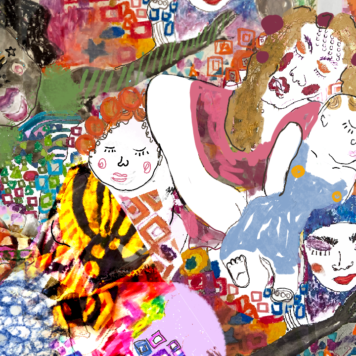Gypsy and Traveller people exist on the margins of society whilst simultaneously occupying a large part of the public imagination. People have long been infatuated with the free-spirited whimsy of the Gypsy stereotype or running away with the showmen’s fair. There are those who have romanticised the idea of living in an ornate bow-top wagon, at one with nature and ‘free’. But at the same time, people fear Gypsies and Travellers as dangerous and deviant outsiders who are a risk to their well-established communities.
Many will be familiar with the old warning uttered by harassed parents to errant young children: “If you don’t behave, the gypsies will come and take you!”
I can still remember my bemusement the first time I ever heard it, not from my own parents but from a stranger recanting a tale from their childhood. It was an awkward encounter as I took my first steps into the Gypsy, Roma and Traveller (GRT) charity sector where speaking at events seemed to invite people to share these stories with you. As someone who comes from a very big Irish Traveller family, with what is likely to be hundreds of second cousins alone, I couldn’t help but think – we have enough of our own children, why on earth would we take yours?
I laughed off the interaction, knowing that if I dissected it with them, I would be met with fragility and defensiveness. The irony is that whilst wider society has constructed and embellished the tale of the nomadic ‘child snatcher’, the state was busy taking children away from Gypsy and Traveller families.
Mark Baillie’s novel Salvage explores the story of 62-year-old Nash on his search, spearheaded by his great niece Emma, for his sister wee Jenny, who was ripped away by state officials and police in Scotland and never seen again. It was an act that unleashed a torrent of pain, buried deep in a family that never quite recovered from the loss. There was the echo of forced assimilation and the struggle for Emma’s dad to adapt to a new world where traditional trades no longer made ends meet. The search is made even more pressing by Nash’s worsening health.
After reading Salvage and speaking with Mark, it was clear to see how Nash’s fictional story could have been any of ours. The tapestries of our lives as Gypsies and Travellers are beautifully rich but often littered with pain and tragedy at the hands of the state. In countries across the world, nomadic and Indigenous peoples have often found themselves falling victim to governments and institutions that do not see their lives and cultures as worthy.
People are often familiar with the stories of forced assimilations and brutality faced by the Indigenous people in America and Canada where their children were taken, stripped of their culture and heritage, and beaten into submission in state sanctioned religious schools. But people rarely understand that Gypsies and Travellers have also been subject to assimilationist policies and practices, official and unofficial, for hundreds of years.
For Mark, who has Scottish Gypsy-Traveller heritage through his paternal grandparents, the inspiration for Salvage came from an oral history project he undertook with his grandfather. Whilst his grandfather’s memories had some gaps due to ill health and age, they provided an insight into a way of life that he himself didn’t have, and a few years later he revisited those oral recordings with a view to developing something creative from the half stories he had been told. It was the story of his grandfather that inspired the subplot for Nash’s nephew Spence, capturing the struggle for a generation, particularly men who were pushed into housing but equipped with a hawking trade that relied on nomadism. I also think that in some ways, Mark touches on a less talked about identity struggle for families who have grown up partially (or fully) disconnected from Gypsy and Traveller life and traditions, but experience the generational impact of the trauma of assimilation.
Irish Commission on Itinerancy
In Ireland, the 1963 Report of the Commission on Itinerancy detailed the assimilationist practices that the Irish government took in order to settle, “rehabilitate” and assimilate Travellers with the Irish Prime Minister Charles Haughey stating, “there can be no final solution of the problems created by itinerants until they are absorbed into the general community” pg 111. Through this commission, Irish Travellers were forcibly settled on sites with inadequate facilities and in houses, and subjected to greater policing and surveillance by various state actors including social workers, health care professionals, religious organisations and the police. Travellers were created as a problem in the public imagination and as such they were treated as a problem that needed to be solved.
It isn’t hard to see, even in the current day, how the British government has continued to problematise Gypsies and Travellers. In their attempts to solve this ‘Traveller problem’, they have tried to curtail the nomadic cultural tradition and practices of Gypsies and Travellers by closing long used lay-bys and stopping places, making it more difficult to hold traditional fairs and gatherings, and introducing legislation to prevent Gypsies and Travellers from setting up camp through the Police, Crime Sentencing and Courts Bill. Whilst part 4 of the bill wasn’t bold enough to state that their primary aim was forced settlement and assimilation, it isn’t hard to see the similarities with the Irish Commission on Itinerancy.
Trawling through the Raidió Teilifís Éireann archives, I came across a video of my maternal great grandfather. But beyond the joy of being able to put a voice and young face to the name, a callous remark made my blood run cold. “As far as I can see, the only hope of ever doing away with the tinkers, would be to take the child from the parents” said an unnamed man in a 1968 newsbeat report entitled ‘No Welcome for Travellers’ recorded in Galway, Ireland.
It wasn’t that I was surprised by the comment, it was more of a gut-wrenching realisation that what he said was exactly what would happen. Not to all Irish Traveller families, but we certainly know from stories and campaigns that some families did have their children taken away, and across the sea in Scotland, a similar fate was affecting Gypsy-Traveller families.
Tinker Experiments in Scotland
I first learned about the Tinker experiments in Scotland due to the work of voracious campaigner Dr. Lynne Tammi-Connolly. For as long as I have followed her, she has spoken out about the historic injustice whilst simultaneously situating it in the continued impact it has today for Gypsy-Traveller families. Recently she tenaciously undertook a walk from her home to the Scottish parliament, a distance of more than a hundred miles, to draw attention to the Tinker Experiments campaign and try to get politicians to listen.
Similarly to the Irish commission, the Tinker experiment was a social experiment to settle Gypsy-Traveller families and assimilate them into mainstream society. The policy saw families forcibly settled on sites that had no electricity and were not fit for purpose, and those who did not settle were threatened with the forced adoption of their children. It was a policy and practice that was supported by the UK Government and carried out by Local Authorities in Scotland.
We know that it was not an empty threat.
The Tinker Experiments officially began in the 1940s and came to an end in the 1980s. However, we also know that forced adoptions took place prior to this too, with the Church of Scotland and other religious institutions playing a sizeable role in removing children and interning them in industrial schools or sending them to the colonies.
In 2022, The Scottish government commissioned research to explore the Tinker Experiments, and establish a timeline, roles and decisions for the periods in which it took place. Dr. Lynne also travelled to Canada to undertake further research on the Gypsy-Traveller children who were trafficked there after being removed from their families. However, the September 2024 deadline for the publication of this research has since passed and communities are still waiting.
The experiments had a devastating impact on Gypsy-Traveller families, especially those who had their children stolen from them and deprived of their family, culture and heritage. For those who were settled, the poor state of the provision left families with long lasting impacts on their physical and mental health, economic challenges as traditional work and employment practices were curtailed, continuing the marginalisation of Gypsy-Traveller families in Scotland. It was cultural genocide and an act for which the Scottish government is yet to apologise.
What can you do?
- Read Salvage by Mark Baillie. It is a great introduction for those who are new to the histories of Gypsy-Traveller people. Fiction has an important role to play in imagining new futures and in the case of Salvage, in campaigning to address the wrongs of the past.
- Support the campaign for an apology from The Scottish Government for the Tinker Experiments and write to your local politician to put pressure on the Scottish government
- Actively support and advocate for Gypsy and Traveller people today, pushing back against policies trying to curtail Gypsy and Traveller people and their cultural practices
- Educate yourself on the impact that historic assimilationist practices have had on Gypsies and Travellers in the current day, particularly in health and education
- Read: What is Gypsy and Traveller resistance?














